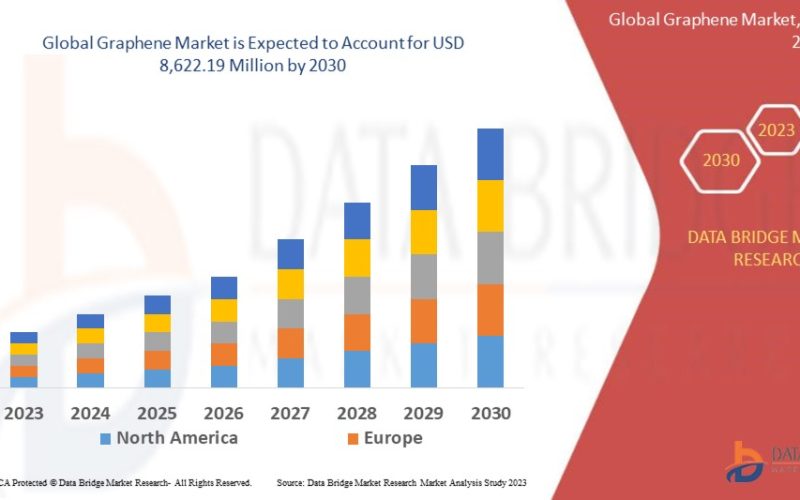Introduction
Graphene is like a super-thin carpet made of carbon atoms, all linked together in a honeycomb shape. Even though it’s only one atom thick, it’s incredibly strong, bends easily, and lets electricity and heat flow through it really fast. Because of these superpowers, scientists and engineers are excited to use graphene in things like smartphones, batteries, airplanes, cars, and even medical tools.
In this article, we’ll explore the global graphene market what’s happening right now, why it’s growing so quickly, the cool new technologies using graphene, the challenges people face, how the market is divided into different parts, what’s going on in different parts of the world, and what might come next up to the year 2033.
What Is Driving Graphene Market Growth?
Graphene is a very thin, super-strong material that’s great at carrying electricity. Electronics makers use it to build faster computer chips and bendable screens. Battery companies add graphene to lithium-ion cells so they charge quickly and last longer. Car and airplane builders mix graphene into parts to make them lighter and save fuel. Doctors and engineers are testing graphene for tiny sensors and smart ways to deliver medicine. All these uses help turn graphene from a lab idea into real products kids can see and use every day.
Market Overview
The global graphene market has experienced robust growth in recent years, driven by increased research and commercialization of graphene-based products. In 2024, the market was valued at approximately USD 620 million and is projected to surpass USD 2.5 billion by 2033, growing at a compound annual growth rate (CAGR) of around 16.8% during the forecast period. Key applications in flexible electronics, energy storage, thermal management, and composites are driving market expansion.
Key Market Drivers
1. Surging Demand in Electronics and Semiconductors
Graphene’s high electrical conductivity and flexibility make it an ideal material for advanced electronic devices such as flexible displays, transistors, sensors, and conductive inks.
2. Energy Storage and Battery Applications
Graphene is increasingly used in supercapacitors and lithium-ion batteries due to its high surface area and rapid electron mobility, enhancing energy density and charge/discharge rates.
3. Lightweight and Strong Composite Materials
Incorporating graphene into polymers and metals improves mechanical strength, heat resistance, and corrosion protection, making it valuable in automotive and aerospace components.
4. Healthcare and Biomedical Innovations
Graphene is gaining traction in drug delivery, biosensors, imaging, and tissue engineering due to its biocompatibility, conductivity, and surface modification capabilities.
5. Rising Investments in R&D and Commercialization
Government initiatives, private investments, and academic research are accelerating the development of scalable production methods and real-world applications of graphene.
Major Applications Shaping Demand
Graphene has special powers that help many industries. In electronics, it makes clear, bendy wires for touchscreens and super-fast computer parts. In energy, thin graphene layers help build better fuel cells and super-fast chargers. When mixed into plastics and metals, graphene makes them stronger, tougher, and able to handle heat. In medicine, tiny graphene sensors can spot diseases even when there are very few germs. For cleaning water, graphene filters catch more dirt and chemicals than regular filters. All these cool uses help the graphene market grow and spark new ideas everywhere.
Regional Forecasts and Market Size
North America is in the lead today because companies there spend lots of money on research and love trying new graphene ideas, especially around Silicon Valley. Europe comes next, where engineers in Germany and the UK are using graphene for cars and airplanes. The Asia-Pacific region places like China, South Korea, and Japan is growing the fastest by building small graphene factories and backing new startups. Right now, the whole world’s graphene market is about $1.2 billion (that’s $1 200 000 000) in 2023, but by the year 2033 it could grow to over $10 billion ($10 000 000 000). In Asia-Pacific, the market might grow by about 25–30% each year, while in North America and Europe it could grow by around 15–20% every year.
Market Segmentation
1. By Type
- Monolayer Graphene
- Few-layer Graphene
- Graphene Oxide
- Reduced Graphene Oxide
- Graphene Nanoplatelets
2. By Application
- Electronics
- Energy Storage
- Composites
- Biomedical Devices
- Coatings and Inks
- Thermal Management
3. By End-Use Industry
- Automotive
- Aerospace and Defense
- Healthcare
- Electronics
- Energy
- Packaging
- Construction
Regional Insights
1. North America
North America holds a significant share in the global graphene market due to strong research infrastructure, advanced manufacturing capabilities, and early adoption in the electronics and aerospace sectors. The U.S. is a leading market due to increasing partnerships between startups and large manufacturers.
2. Europe
Europe is a major graphene hub with strong support from the European Union’s Graphene Flagship initiative. Countries like the UK, Germany, and Sweden are investing in graphene innovation and commercialization.
3. Asia-Pacific
The Asia-Pacific region is expected to witness the fastest growth during the forecast period. China, South Korea, and Japan are heavily investing in graphene production, particularly for electronics, batteries, and automotive applications.
4. Latin America and Middle East & Africa
These regions are in the early stages of graphene adoption but offer potential growth opportunities, particularly in energy storage and construction sectors due to expanding industrial bases.
Technological Trends
- Scalable Production Techniques: Advancements in chemical vapor deposition (CVD), exfoliation, and reduction of graphene oxide are improving the scalability and cost-effectiveness of graphene production.
- Flexible and Wearable Electronics: Graphene’s use in stretchable, transparent conductors is enabling innovations in wearable devices, foldable screens, and electronic skin sensors.
- Thermal Interface Materials (TIMs): Due to its excellent thermal conductivity, graphene is being used in thermal interface materials for heat dissipation in high-performance electronics and EVs.
- Additive Manufacturing: Graphene-infused filaments and resins are being used in 3D printing to develop lightweight, conductive, and durable components.
Market Challenges and Opportunities
Graphene has amazing potential, but there are some bumps on the road. Making very pure graphene in large amounts is still expensive. It’s also hard to know if one batch of graphene is the same quality as another, so buyers can’t easily tell which product to choose. Rules about how safe and healthy graphene is are not fully clear yet. That makes some companies nervous.
But these challenges also bring chances for smart businesses. If a company figures out how to make graphene more cheaply and reliably, it can become a market leader. Working together—producers talking with the people who actually use graphene—helps make sure the material meets real needs. As experts create clear rules and testing methods, more industries will feel safe using graphene and its use will grow fast.
Here are the main hurdles:
- High Production Costs: Getting top-quality graphene still costs a lot, which makes big projects hard to afford.
- No Common Standards: Different graphene makers have their own ways of measuring quality, so it’s tough to compare products.
- Hard to Add into Products: Factories often need new machines or steps to use graphene, so many stick with older materials.
- Safety Questions: Scientists need to study more to be sure graphene is safe for people and the planet before it can be used everywhere.
Competitive Landscape
The graphene market features a mix of startups, research institutions, and established materials companies. Key players are focusing on strategic partnerships, product launches, and expanding production capacity. Major companies include:
- Graphenea SA
- XG Sciences Inc.
- First Graphene Ltd
- Haydale Graphene Industries
- Applied Graphene Materials
- Versarien plc
- ACS Material, LLC
- Nanoxplore Inc.
- Perpetuus Advanced Materials
- Directa Plus
Future Outlook (2025–2033)
- Mass Adoption in Consumer Electronics: Flexible, graphene-based electronics are expected to become mainstream, influencing smartphones, tablets, and wearable tech.
- Electric Vehicle Revolution: Graphene-enhanced batteries and composites will play a crucial role in improving range, safety, and efficiency of electric vehicles.
- Green Energy Solutions: Graphene’s integration into solar panels and hydrogen fuel cells will support the global shift toward sustainable energy systems.
- Expansion into Construction and Coatings: Graphene will increasingly be used in paints, sealants, and concrete to enhance durability, strength, and corrosion resistance.
Source: https://www.databridgemarketresearch.com/reports/global-graphene-market
Conclusion
The global graphene market is poised for transformative growth, driven by rapid technological advancements and increasing demand across diverse industries. While challenges related to cost and standardization remain, ongoing research, supportive government initiatives, and expanding industrial applications are expected to unlock graphene’s full potential. Companies that strategically invest in graphene technologies will be well-positioned to lead in the next generation of materials science and innovation.












